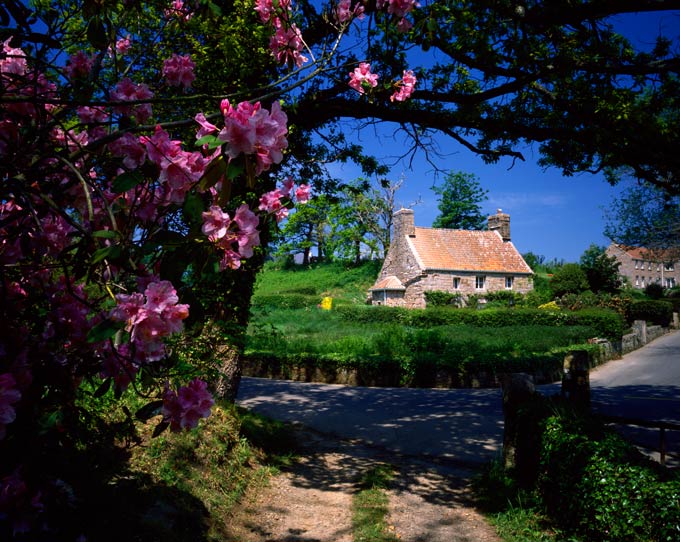
With their golden beaches and warm climes you could be forgiven for forgetting that the Channel Islands are part of the British Isles. A scattering of strongholds dating back to the 13th century line the idyllic coastlines as a reminder of the islands’ event-strewn history.

St Lawrence, on Jersey
Some yards back from the pebbled peace of Bouley Bay there lies a path, winding a narrow trail through mustard-yellow gorse, up steep steps, twisting and stooping beneath a cherry blossom bower, speckled along its hedgerows with tiny violets, until it reaches its highest point – the cliff walk to Bonne Nuit Bay. Beautiful, rugged, picturesque, the sea stretching the eye towards Cherbourg. For this is Jersey, the largest of the Channel Island jewels, hooked under the tip of the north French coast.
Only nine by five miles, Jersey is a world apart. Rated one of the sunniest spots in Britain, with its azure sea, golden beaches and warmer climate its feel is distinctly Mediterranean. And yet, this charming island is not so easy to pinpoint, steeped as it is in French and English culture. From the rugged cliff-tops of the northern shore, to the more sultry, picture-postcard coves of the south, to the unspoilt countryside of fields, woodlands and winding lanes, there is something here for everyone.
History-lovers might look no further than the 16th-century Elizabeth Castle. A rocky promontory reached by boat or on foot at low tide, its construction was supervised by Sir Walter Raleigh who named the castle in honour of his Queen. With its towers and battlements it is an impressive site, famed as a Royalist bastion and for its protection of Charles II during the English Civil War. An even earlier monument is the awe-inspiring 13th-century stronghold, Mont Orgueil castle, built into the cliff-side with a series of fortified terraces. But the real treasure lies at La Hougue Bie, a Neolithic ritual site built around 4000 BC. This is one of Europe’s most impressive passage graves, with its inner sanctum aligned to the rising sun of the equinox. Atop its significant burial mound is a pretty 12th-century chapel, Notre Dame de la Clarté, a tacit statement of Christian dominance over pagan worship.
Jersey itself has a painful history of dominance from its time during the German Occupation. The haunting War Tunnels are a moving testament to the islanders who suffered, and to the tales of heroism – and collaboration – that emerged. Likewise, the numerous German bunkers built around Jersey’s 48-mile coastline are a chilling reminder of these past events.
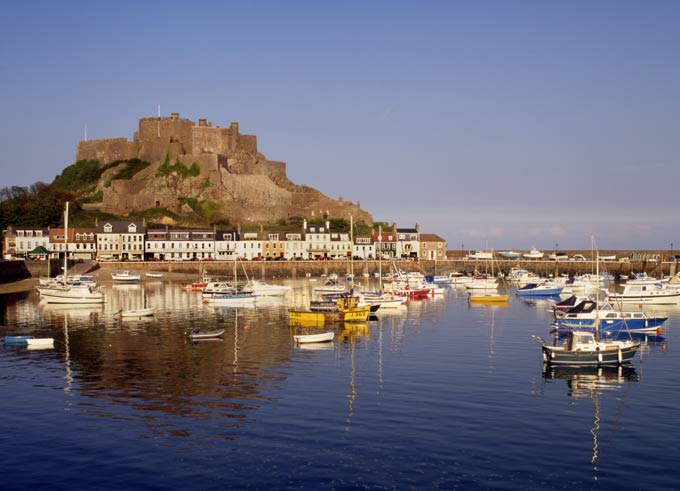
The beaches themselves, however, are wonderful. The longest, St Ouen’s, with its five-mile arc of golden sands and strong rolling waves is a surfer’s paradise. The ever popular El Tico’s, a buzzing beachside café/cantina offers great views and great food. To the south of the island lies the beautiful St Brelade’s beach. Overlooking this sandy stretch is the tiny, picturesque Fisherman’s chapel, where if you follow the path upwards you may begin another of Jersey’s stunning cliff walks. This trail leads all the way to the Corbière lighthouse, which one might hire as a holiday home with unsurpassed views. Halfway along this cliff route, the hidden gem of Beauport Bay is revealed. This small, secluded hideaway is reached only by a steep downward climb. But it is worth it, especially if you are planning to bring a picnic and spend the day. For those less inclined to picnic, the best beach café has to be the delectable Hungry Man, a colourful kiosk out at Rozel Harbour – an idyllic spot to sample delicious crab sandwiches, cream teas and homemade cakes.
There is even plenty for the more adventurous traveller, from rock climbing to wind-surfing and kayaking, and cycling along the old railway line, now a leafy lane, all the way from Corbière lighthouse to the pretty harbour of St Aubin. Jersey’s 50 miles of go-slow Green Lanes are the perfect antidote to city life, and a mark of the island’s growing commitment to conservation.
Nowhere is this more apparent and inspiring than at the Durrell Wildlife Conservation Trust, begun in 1959 by the pioneering Gerald Durrell. Durrell’s radical mission to preserve species changed thinking worldwide, and today the Trust has become a unique hybrid of zoo-keeping and international conservation, with currently 50 conservation projects in 14 countries. As its Honorary Director, Lee Durrell, reminds us, “the nuts and bolts of the ecosystem which support humankind are animal and plant species.” The Durrell Trust is a treat for the whole family: you can watch the gorillas and flamingos, walk around the organic farm, and sample its produce in the fantastic new restaurant, Café Firefly.
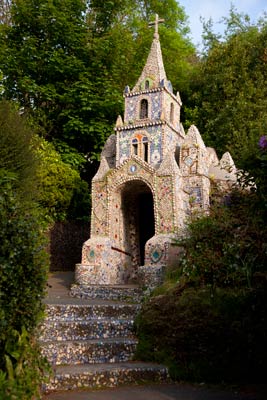
But the magic of the Channel Islands does not stop here. A short hop brings us to the smaller island of Guernsey, in some ways a more relaxed and olde-worlde counterpart to Jersey. In the late summer of 1883, the artist Pierre-Auguste Renoir stayed in the quaint seaside harbour town of St Peter Port. The pretty cobbled streets and traditional atmosphere here make it easy to understand his fascination. How frequently he must have followed the narrow granite cliff paths that run all the way from St Peter Port to Pleinmont in the south-west. At Moulin Huet he set up his easel and produced 15 paintings of the bay and its beautiful, secluded cove, where it is said Victor Hugo liked to bathe and picnic during his exile on the island. At each turn of the path a new vista is revealed: a collection of fishing boats; a smuggler’s cave; then a rocky outcrop swarming with seabirds.
After a morning’s walk there is no better place to refuel than the Fermain Beach Café, especially for a slice of ‘steak sandwich heaven.’ In fact, Guernsey is renowned for being an island that likes its own locally produced food. This can be clearly seen by the number of unmanned roadside stalls selling home-grown produce, known as ‘hedge veg.’ Fresh lobster, prawns and shellfish appear on every restaurant’s menu, and if you happen to visit between January and April there is a good chance you will find locals in their wellies in search of the famously elusive abalone shellfish. Alternatively, for a real treat, an early evening boat will take you to the tiny island of Herm, for dinner at the White House Hotel. Here you can sit with a glass of wine on the lawn, watching the sun set over the idyllic and utterly unspoilt bay. Or for less formal, good hearty fare, trot along to the cheery Mermaid’s Tavern before catching the last boat home.
If it is peace and quiet you are looking for then a short ride in a 12-seater plane will bring you to the charming island of Alderney. Just one-and-a-half miles wide and three-and-a-half miles long, Alderney has its own distinctive feel and an enviable array of wildlife, from puffins, peregrines and guillemots, to the famous blond hedgehog, whose unique residence in Alderney remains a mystery. The best way to explore is on foot across the commons and dramatic cliff tops of the south, past Victorian and German fortifications, to the beautiful sandy beaches of the north and east coasts. Of particular note is the perfectly curved Saye Beach (pronounced Soy), protected by rocky headlands at either end.
But walkers might be given a reprieve, for surprisingly, Alderney boasts its very own railway. Built in the 1840s by the British Government to enable its fort-building process, it is one of the oldest lines in the British Isles, honoured by Queen Victoria herself. Running on bank holidays and weekends during the summer, the train takes you right across the island from the harbour at Braye, and out towards Mannez Lighthouse, Alderney’s most prominent landmark.
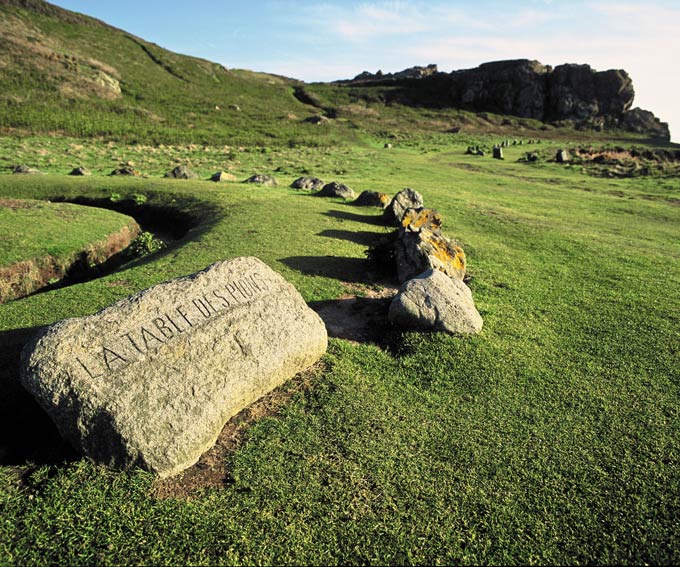
Another landmark worth visiting is St Anne’s Church, considered one of the most beautiful Victorian buildings in the islands. The quaint cobbled streets of the town of St Anne and its pretty pastel-coloured Georgian houses are a delight, especially during Alderney Week – the island’s most famous event – when burning torches are carried through the narrow lanes on their way to a bonfire and fireworks display. With more than 130 organised events every August, many visitors come back year after year for the festival atmosphere and events ranging from a Daft Raft Race around the bay to an amazing flying machine competition.
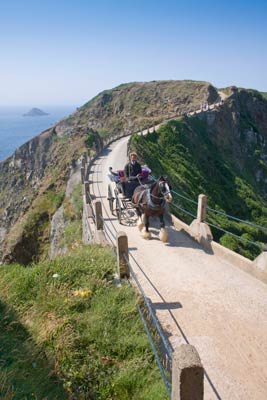
But no exploration of the Channel Islands is complete without a final sojourn on Sark. To come here is to step back in time. Without cars or traffic – save the occasional tractor – and abundant with wildflowers, sandy lanes, steep cliffs, daredevil caves and tiny golden coves, this tranquil haven is a delight. Just three miles long and one-and-a-half miles wide, Sark puts a spell on its visitors. The best way to see it is either by foot or bicycle, or if that is too exerting, a gentle ride in a horse and cart can take you on a tour. The Avenue comprises the main shopping area of Sark, where locally made pottery and jewellery can be bought. Crafts, fishing and farming provide employment for the 600 inhabitants, in addition to the excellent collection of hotels and restaurants. Of particular note is the award-winning La Sablonnerie Hotel with its low beams, open fireplace and whitewashed stone. To reach the hotel, you must first cross The Coupee, the razor-edged isthmus that connects the main body of Sark to its tiny appendage of Little Sark. Here cyclists are asked to dismount, for the crossing is incredibly narrow. The height and sheer drop is disconcerting enough, let alone imagining the crossing without railings one hundred years ago, when children were forced to crawl on their hands and knees to prevent the wind from pushing them over!
For walkers, springtime is a joy: the Dixcart Valley comes alive with bluebells and wild garlic, and the cliff tops brim over with campion and foxgloves. Wildlife flourishes on this isolated island. With no light pollution, the Sark night sky is a feast for the eyes – on a clear night the entire Milky Way can be seen. And there is plenty here to whet the historian’s appetite. From the Bronze Age settlement, to the Romans who governed the island (Sarmia, as they called it) for two centuries, to the monks who came in 565AD from Mont St Michel, to pirate invasions, to finally being designated feudal land by Elizabeth I and gifted to the Seigneur (Lord) of Jersey. Whatever turbulence Sark has seen is now far in the past, replaced by an almost enchanted calm.
These islands have so many secrets to share, so many hidden gems to discover, that each visit turns up something new. From Karl Marx to Rudyard Kipling, Charlie Chaplin to George Eliot, it is no wonder that even the Channel Islands’ most illustrious guests returned year on year for a slice of Anglo-French charm.


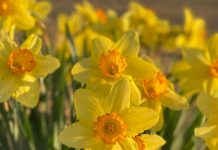


 © 2024
© 2024